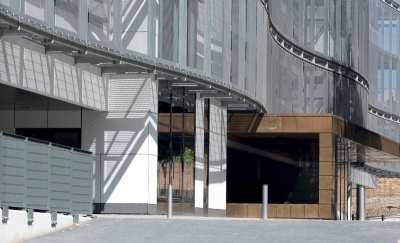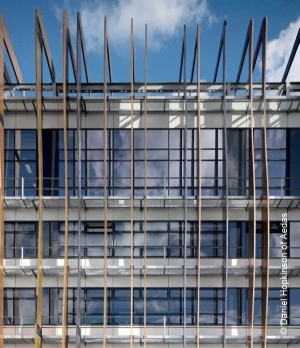Holland Park School, London
Structural Steel Design Awards 2014 - Award
Opened in 1958 Holland Park School is one of England’s most well known state schools.
Over the years the school buildings had become inflexible and suffered from severe cold and overheating problems as well as poor circulation. The project to redevelop the school has rectified these issues while also satisfying the brief to sit comfortably within the Holland Park Conservation Area.
The new 1,500 pupil school maintains an equivalent amount of external play space, while consolidating the previous sprawling 1950s campus style development into a more compact footprint and so providing a flexible teaching environment fit for the 21st Century.
The project has been funded by the sale of a portion of the school’s sports grounds, on the understanding that the new design would ensure there would be no loss in external sports facilities.
Despite standing on a smaller site, the new Holland Park School has both larger internal accommodation and external areas than its predecessor as a result of efficient design and innovative use of space that was realised through the use of steelwork for the primary structural frame.
The new school building, which has achieved a BREEAM ‘Excellent’ rating, is approximately 100m long and 30m wide, consisting of five above ground levels as well as a 7m deep basement that extends over the entire footprint.
The basement accommodates a sports hall, a 25m four-lane swimming pool, kitchen and dining areas.
Above ground the school building is split into two wings: to the east are the generic teaching spaces, while to the west the structure houses the specialist teaching zones. The latter is constructed with a dramatic steel A-frame that straddles the larger spaces within the basement to create clear span spaces without the need for transfer structures.
Steel bridges and stairs link the two wings across an open glazed central atrium that extends the whole length of the building. As well as creating the basement’s open spaces, the A-frame also provides a dramatic form to the atrium, maximising the penetration of natural light deep into the building and classrooms.
The A-frame’s raking columns support tiered floor plates at every level, with each one becoming broader as the raking member descends. The daylit tiers serve as circulation and breakout zones, and informal learning spaces encompassing IT clusters.
Consequently the A-frame is the signature piece of the atrium, helping to orientate users of the building and allowing optimum supervision of students at all times.
The basement beneath the A-frame was required to be column free for complete flexibility. To achieve this, internal columns were hung from roof level, with large plate girders transferring the loading from the classrooms to the perimeter columns.
Pre-stressed planks were used for the frame’s floor slabs as they provided high quality exposed soffits for thermal mass. The frame is constructed with regular 610mm beams with 350mm H sections for the bracing. These are set on a double grid to work with the classroom layouts, while a system of K-bracing was inserted to allow for doors to be set within each bay for future flexibility.
As the structural integrity of the A-frame was not complete until it was entirely constructed, temporary central columns were used within the basement. Once the frame was erected, these columns were removed leaving the upper central columns suspended from the A-frame.
Monitoring was necessary during the removal of the temporary columns, but movements were found to be only a few millimetres.
Given the school’s location within a Conservation Area and adjacent to the Royal Borough of Kensington and Chelsea’s largest park, the design focused on creating a sympathetic relationship with local residential buildings and accentuating the connections with the park.
This has been achieved, in part, through the addition of a striking façade made up of copper, brass and bronze that adds character to the building and integrates with the heavily wooded nature of the site. The use of brise soleil softens the impact of the large building and also fulfils the primary function of sustainability by reducing solar gain and glare.
The project was one of the first jobs in the UK to make use of the Revit BIM software. This was used by all of the principal disciplines involved with the project, and was then provided to the contractor to assist in the coordination and production of the fabrication and installation drawings.
The use of steel allowed the team to create a dramatic architectural form with clear spans, while maximising offsite construction that in turn reduced noisy on site working hours. Steel also made the structural frame lighter than alternative materials and consequently reduced the extent of foundation work.
| Architect | Aedas |
| Structural Engineer | Buro Happold Ltd |
| Main Contractor | Shepherd Construction |
| Client | The Royal Borough of Kensington and Chelsea |
Judges' comment
The specialist classroom block at this prominent school has braced steel walls at regular spacing, both to span the large sports and assembly spaces, and to respond to the inclined support along one side where the atrium widens as the building rises.
This clever solution provides large column-free classrooms and open, dynamic circulation spaces at the heart of this meticulously designed school.






